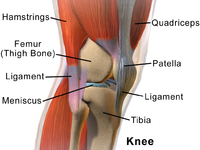
Photo from wikipedia
Purpose To develop a mapping model to estimate EQ-5D-3L from the Knee Injury and Osteoarthritis Outcome Score (KOOS). Methods The responses to EQ-5D-3L and KOOS questionnaires ( n = 40,459 observations)… Click to show full abstract
Purpose To develop a mapping model to estimate EQ-5D-3L from the Knee Injury and Osteoarthritis Outcome Score (KOOS). Methods The responses to EQ-5D-3L and KOOS questionnaires ( n = 40,459 observations) were obtained from the Swedish National anterior cruciate ligament (ACL) Register for patients ≥ 18 years with the knee ACL injury. We used linear regression (LR) and beta-mixture (BM) for direct mapping and the generalized ordered probit model for response mapping (RM). We compared the distribution of the original data to the distributions of the data generated using the estimated models. Results Models with individual KOOS subscales performed better than those with the average of KOOS subscale scores (KOOS 5 , KOOS 4 ). LR had the poorest performance overall and across the range of disease severity particularly at the extremes of the distribution of severity. Compared with the RM, the BM performed better across the entire range of disease severity except the most severe range (KOOS 5 < 25). Moving from the most to the least disease severity was associated with 0.785 gain in the observed EQ-5D-3L. The corresponding value was 0.743, 0.772 and 0.782 for LR, BM and RM, respectively. LR generated simulated EQ-5D-3L values outside the feasible range. The distribution of simulated data generated from the BM model was almost identical to the original data. Conclusions We developed mapping models to estimate EQ-5D-3L from KOOS facilitating application of KOOS in cost-utility analyses. The BM showed superior performance for estimating EQ-5D-3L from KOOS. Further validation of the estimated models in different independent samples is warranted.
Journal Title: Quality of Life Research
Year Published: 2019
Link to full text (if available)
Share on Social Media: Sign Up to like & get
recommendations!